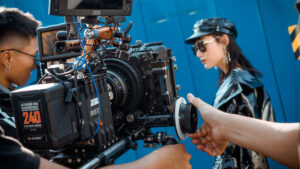The film and entertainment industry has always been at the forefront of technological innovation, and 3D printing is no exception. 3D printing has emerged as a powerful tool in the creation of props, costumes, and even characters in movies and TV shows. In this article, we will explore the use of 3D printing in the film and entertainment industry.
What is 3D Printing?
3D printing, also known as additive manufacturing, is a process of creating a three-dimensional object by layering materials, such as plastic or metal, on top of each other. This technology has revolutionized the manufacturing industry, providing new opportunities for customization and efficiency.
The Use of 3D Printing in the Film and Entertainment Industry
The film and entertainment industry is always looking for new ways to create immersive experiences for audiences. 3D printing has emerged as a key technology in this endeavour, providing a powerful tool for creating props, costumes, and even characters.
Customization
One of the key benefits of 3D printing in the film and entertainment industry is the ability to create custom designs and components. This allows filmmakers and designers to create props and costumes that are tailored to the specific needs of the movie or TV show. For example, 3D printing can be used to create custom weapons and armor for action scenes, or to create intricate and detailed costumes for fantasy or sci-fi movies.
Speed and Efficiency
3D printing is also faster and more efficient than traditional manufacturing techniques, allowing for the rapid production of props and costumes. This can be particularly useful in the fast-paced world of movie and TV production, where time is of the essence and delays can be costly.
Cost Savings
The use of 3D printing can also lead to cost savings in the production of props and costumes. Traditional manufacturing techniques can be expensive and time-consuming, but 3D printing allows for the rapid production of custom components at a lower cost.
Design Flexibility
3D printing also offers greater flexibility in the design and production of props and costumes. This allows filmmakers and designers to experiment with different designs and materials, creating props and costumes that are more adaptable and responsive to changing needs.
Applications of 3D Printing in the Film and Entertainment Industry
There are numerous applications of 3D printing in the film and entertainment industry. Here are some of the key applications:

Props: 3D printing can be used to create custom props for movies and TV shows. This allows filmmakers and designers to create props that are tailored to the specific needs of the production, such as weapons, vehicles, and other objects.
Costumes: 3D printing can also be used to create custom costumes for movies and TV shows. This allows filmmakers and designers to create intricate and detailed costumes that are tailored to the specific needs of the production.
Characters: 3D printing can be used to create characters for movies and TV shows. This includes everything from creating custom masks and prosthetics to creating entire characters using 3D printing technology.
Set Design: 3D printing can also be used to create custom set pieces for movies and TV shows. This allows filmmakers and designers to create immersive and detailed sets that are tailored to the specific needs of the production.
Challenges and Considerations
While 3D printing offers many benefits in the film and entertainment industry, there are also challenges and considerations to keep in mind. Here are some of the key challenges:
Quality Control: The quality of 3D printed props and costumes can vary depending on the quality of the printer and the materials used. This can make it difficult to ensure consistent quality across different productions.
Cost: While 3D printing can lead to cost savings in the production of props and costumes, the cost of 3D printing technology can be high. This can make it difficult for some productions to adopt 3D printing as a key technology.
Skill and Training: The use of 3D printing requires specialized skills and training, which may be a barrier for some productions. This can make it difficult to adopt 3D printing as a key technology in the film and entertainment industry.
Future Trends in 3D Printing and the Film and Entertainment Industry
As 3D printing and the film and entertainment industry continue to evolve, there are several future trends that are emerging in the industry. Here are some of the key trends to watch:

Integration with Virtual and Augmented Reality
The integration of 3D printing with virtual and augmented reality is a growing trend in the industry. By incorporating these technologies, filmmakers and designers can create even more immersive experiences for audiences.
Use of Biodegradable and Sustainable Materials
The use of biodegradable and sustainable materials in 3D printing is a growing trend, particularly in the film and entertainment industry. By using environmentally friendly materials, productions can reduce their carbon footprint and promote sustainability.
Expansion of Additive Manufacturing
The expansion of additive manufacturing, which includes 3D printing and other technologies, is a growing trend in the film and entertainment industry. Additive manufacturing allows for the rapid production of custom components and structures, reducing the time and cost of production.
Customization and Personalization
The trend towards customization and personalization is also growing in the film and entertainment industry. By using 3D printing to create custom props, costumes, and characters, filmmakers and designers can create productions that are tailored to the specific needs of the project.
Conclusion
The use of 3D printing in the film and entertainment industry is significant, providing new opportunities for the creation of props, costumes, and even characters. The use of 3D printing allows for greater customization, speed, efficiency, and design flexibility in the production of movies and TV shows. As the technology continues to evolve, we can expect to see even more innovation and growth in the use of 3D printing in the film and entertainment industry. With careful planning and consideration, 3D printing can be a valuable tool in the creation of immersive and engaging experiences for audiences, and the future possibilities are endless.




